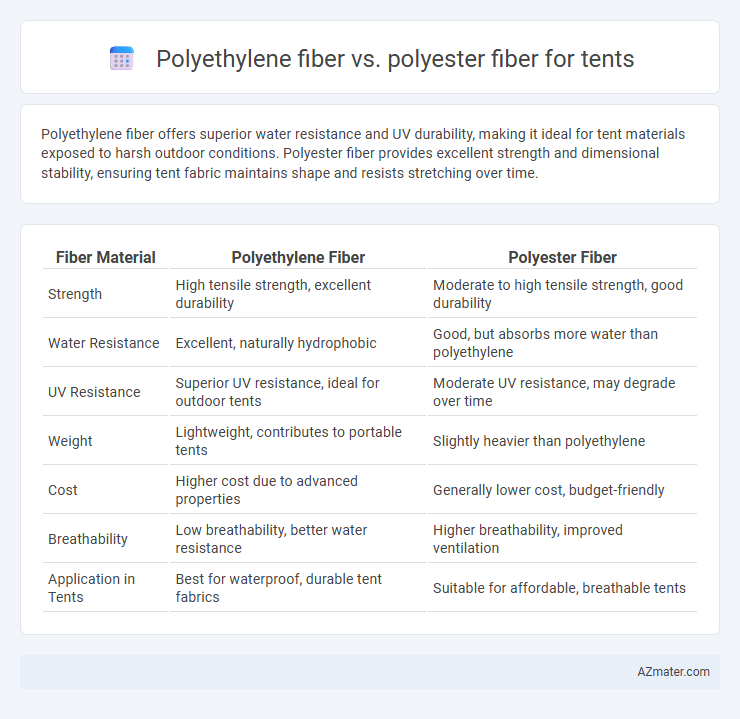Polyethylene fiber offers superior water resistance and UV durability, making it ideal for tent materials exposed to harsh outdoor conditions. Polyester fiber provides excellent strength and dimensional stability, ensuring tent fabric maintains shape and resists stretching over time.
Table of Comparison
| Fiber Material | Polyethylene Fiber | Polyester Fiber |
|---|---|---|
| Strength | High tensile strength, excellent durability | Moderate to high tensile strength, good durability |
| Water Resistance | Excellent, naturally hydrophobic | Good, but absorbs more water than polyethylene |
| UV Resistance | Superior UV resistance, ideal for outdoor tents | Moderate UV resistance, may degrade over time |
| Weight | Lightweight, contributes to portable tents | Slightly heavier than polyethylene |
| Cost | Higher cost due to advanced properties | Generally lower cost, budget-friendly |
| Breathability | Low breathability, better water resistance | Higher breathability, improved ventilation |
| Application in Tents | Best for waterproof, durable tent fabrics | Suitable for affordable, breathable tents |
Introduction to Tent Fabrics
Polyethylene fiber and polyester fiber are two common materials used in tent fabrics, each offering distinct advantages in durability and weather resistance. Polyethylene fiber provides exceptional water resistance and UV stability, making it ideal for lightweight, waterproof tent coverings. Polyester fiber offers high tensile strength and excellent flexibility, ensuring strong structural support and better resistance to stretching and abrasion under prolonged outdoor exposure.
Overview of Polyethylene Fiber
Polyethylene fiber is a lightweight, high-strength material known for its excellent resistance to moisture, UV rays, and abrasions, making it ideal for tent fabrics exposed to harsh outdoor conditions. Its hydrophobic nature prevents water absorption, ensuring tents remain dry and durable over time, while its low density contributes to a lightweight tent structure. Compared to polyester fiber, polyethylene offers superior durability and weather resistance, enhancing the longevity and performance of camping tents.
Overview of Polyester Fiber
Polyester fiber, widely used in tent manufacturing, offers excellent durability, UV resistance, and moisture-wicking properties, making it ideal for rugged outdoor conditions. Its high tensile strength and resistance to stretching ensure long-lasting performance and dimensional stability in various weather environments. Compared to polyethylene fiber, polyester tends to provide better color retention and resistance to mildew, enhancing tent lifespan and appearance.
Strength and Durability Comparison
Polyethylene fiber exhibits superior tensile strength and resistance to abrasion compared to polyester fiber, making it highly durable for tent applications. Its low moisture absorption and resistance to UV degradation enhance long-term performance in harsh outdoor conditions. Polyester fiber offers good strength and elasticity but tends to degrade faster under prolonged UV exposure and moisture, reducing overall tent durability.
Weather Resistance: Polyethylene vs Polyester
Polyethylene fiber demonstrates superior weather resistance in tents due to its excellent water repellency and UV stability, prolonging durability under harsh outdoor conditions. Polyester fiber, while also resistant to weather, tends to absorb more moisture and can degrade faster when exposed to prolonged sunlight. Selecting polyethylene over polyester significantly enhances tent longevity and performance in extreme weather environments.
Weight and Packability
Polyethylene fiber offers exceptional lightweight properties and compressibility, making it ideal for tents requiring minimal pack size and easy portability. Polyester fiber, while slightly heavier, provides superior durability and UV resistance but results in bulkier packs due to its lower compressibility. Choosing polyethylene fiber enhances tent packability without sacrificing strength, while polyester prioritizes long-term performance at the cost of increased weight and volume.
Breathability and Comfort
Polyester fiber offers better breathability compared to polyethylene fiber, making it more suitable for tent fabrics where ventilation is critical to reduce condensation and enhance comfort. Polyethylene fibers provide exceptional water resistance and durability but tend to trap moisture and heat, leading to a less comfortable interior environment. Choosing polyester fiber for tents ensures improved airflow and moisture management, optimizing comfort during extended outdoor use.
Cost and Availability
Polyester fiber for tents tends to be more cost-effective and widely available compared to polyethylene fiber, which is typically pricier due to its specialized manufacturing process. Polyester's extensive production and use in various industries make it easier to source in large quantities, reducing overall material costs for tent manufacturers. Polyethylene fiber, while offering superior moisture resistance and durability, remains less common, impacting both its price and accessibility in the tent market.
Environmental Impact
Polyethylene fiber for tents offers lower energy consumption during production and generates less greenhouse gas emissions compared to polyester fiber, making it a more environmentally friendly choice. Polyethylene is also more resistant to UV degradation, reducing the need for frequent replacements and minimizing waste over the tent's lifespan. Polyester fibers typically have higher recyclability but involve more intensive chemical processes and fossil fuel use, contributing to greater environmental pollution and resource depletion.
Conclusion: Which Fiber Is Better for Tents?
Polyethylene fiber offers superior water resistance and UV stability, making it highly durable in harsh outdoor conditions, while polyester fiber provides excellent tensile strength and abrasion resistance, ensuring long-lasting structural integrity. For tents exposed to prolonged sunlight and moisture, polyethylene's inherent waterproof qualities and resistance to degradation give it an edge. Polyester is preferable when flexibility and strength under tension are critical, but overall, polyethylene fiber is often considered better for tents used in extreme weather environments.

Infographic: Polyethylene fiber vs Polyester fiber for Tent
 azmater.com
azmater.com